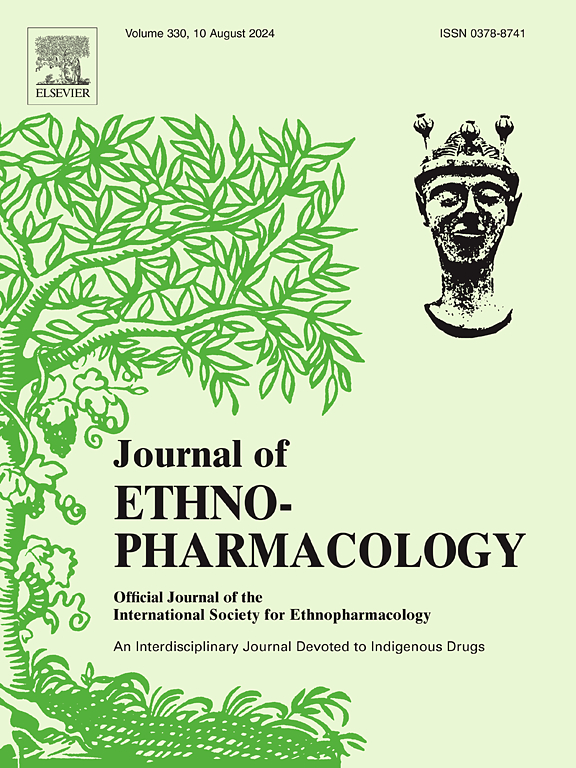Various crystalline forms of realgar exhibit differentiated anti-abscess and anticancer effects based on a PXRD analysis and biological evaluation
IF 4.8
2区 医学
Q1 CHEMISTRY, MEDICINAL
引用次数: 0
Abstract
Ethnopharmacological relevance
Realgar is a mineral medicine with a long history that can be used externally or internally. It is often used to treat skin diseases and leukemia in clinical practice. Realgar exhibits a polycrystalline phenomenon, and it remains unknown whether there is a difference in the efficacies of the different realgar crystalline forms.
Purpose
The aim of this study is to investigate the pharmacodynamic differences of the different realgar crystalline forms (α-As4S4 and β-As4S4) using in vivo and in vitro experiments.
Material and methods
The in realgar crystalline patterns were initially identified using a powder x-ray diffractometer (PXRD). The antimicrobial activities of α-As4S4 and β-As4S4 were then assessed in vitro to elucidate their effectiveness against bacteria. Transdermal absorption and pharmacokinetic experiments were used to investigate the variances in the bioavailabilities between the in vitro and in vivo conditions. The effects of α-As4S4 and β-As4S4 for skin abscess healing were studied in mice using a subcutaneous injection of Staphylococcus aureus (S. aureus). HL-60 cells were exposed to a serum that contained different crystalline forms of realgar to evaluate the potential differences in the therapeutic effects of α-As4S4 and β-As4S4 on leukemia.
Results
Realgar is composed of α-As4S4 and β-As4S4 crystalline forms. The soluble arsenic content in α-As4S4 generally exceeded that of β-As4S4, and the antimicrobial activity showed a positive correlation with the soluble arsenic content. α-As4S4 demonstrated a higher in vivo and in vitro bioavailability and a faster elimination rate in vivo compared to β-As4S4. The pharmacodynamic experimental investigations showed that α-As4S4 exhibited a superior healing effect on subcutaneous abscesses. Furthermore, serum pharmacology experiments revealed that α-As4S4 induced significantly higher membrane damage and apoptosis in HL-60 cells compared to β-As4S4.
Conclusion
The different realgar crystalline forms had distinct pharmacodynamics. α-As4S4 demonstrated higher bioavailability in vitro and in vivo and superior effects on skin abscess healing compared to β-As4S4. It also possessed anti-leukemia properties. It is the first time to report the differences in the efficacy between two crystalline forms of realgar, which is helpful to improve the knowledge of the real chemical substances for realgar.

根据 PXRD 分析和生物评估,各种结晶形式的雄黄具有不同的抗脓肿和抗癌效果。
民族药理学意义:雄黄是一种历史悠久的矿物药,可外用或内服。临床上常用于治疗皮肤病和白血病。目的:本研究的目的是通过体内和体外实验研究不同的雄黄结晶形态(α-As4S4 和 β-As4S4)的药效学差异:使用粉末 X 射线衍射仪(PXRD)初步确定了食醋中的结晶形态。然后在体外评估了 α-As4S4 和 β-As4S4 的抗菌活性,以阐明它们对细菌的有效性。透皮吸收和药代动力学实验用于研究体外和体内条件下生物利用率的差异。通过皮下注射金黄色葡萄球菌,研究了 α-As4S4 和 β-As4S4 对小鼠皮肤脓肿愈合的影响。将 HL-60 细胞暴露于含有不同结晶形式雄黄的血清中,以评估 α-As4S4 和 β-As4S4 对白血病治疗效果的潜在差异:雄黄由 α-As4S4 和 β-As4S4 结晶体组成。与 β-As4S4 相比,α-As4S4 的体内和体外生物利用度更高,体内消除速度更快。药效学实验研究表明,α-As4S4 对皮下脓肿有更好的愈合效果。此外,血清药理学实验显示,与 β-As4S4 相比,α-As4S4 诱导 HL-60 细胞膜损伤和细胞凋亡的程度明显更高:与β-As4S4相比,α-As4S4在体外和体内的生物利用度更高,对皮肤脓肿愈合的效果更好。它还具有抗白血病的特性。这是首次报道两种结晶形式的雄黄在功效上的差异,有助于提高人们对雄黄真正化学物质的认识。
本文章由计算机程序翻译,如有差异,请以英文原文为准。
求助全文
约1分钟内获得全文
求助全文
来源期刊

Journal of ethnopharmacology
医学-全科医学与补充医学
CiteScore
10.30
自引率
5.60%
发文量
967
审稿时长
77 days
期刊介绍:
The Journal of Ethnopharmacology is dedicated to the exchange of information and understandings about people''s use of plants, fungi, animals, microorganisms and minerals and their biological and pharmacological effects based on the principles established through international conventions. Early people confronted with illness and disease, discovered a wealth of useful therapeutic agents in the plant and animal kingdoms. The empirical knowledge of these medicinal substances and their toxic potential was passed on by oral tradition and sometimes recorded in herbals and other texts on materia medica. Many valuable drugs of today (e.g., atropine, ephedrine, tubocurarine, digoxin, reserpine) came into use through the study of indigenous remedies. Chemists continue to use plant-derived drugs (e.g., morphine, taxol, physostigmine, quinidine, emetine) as prototypes in their attempts to develop more effective and less toxic medicinals.
 求助内容:
求助内容: 应助结果提醒方式:
应助结果提醒方式:


